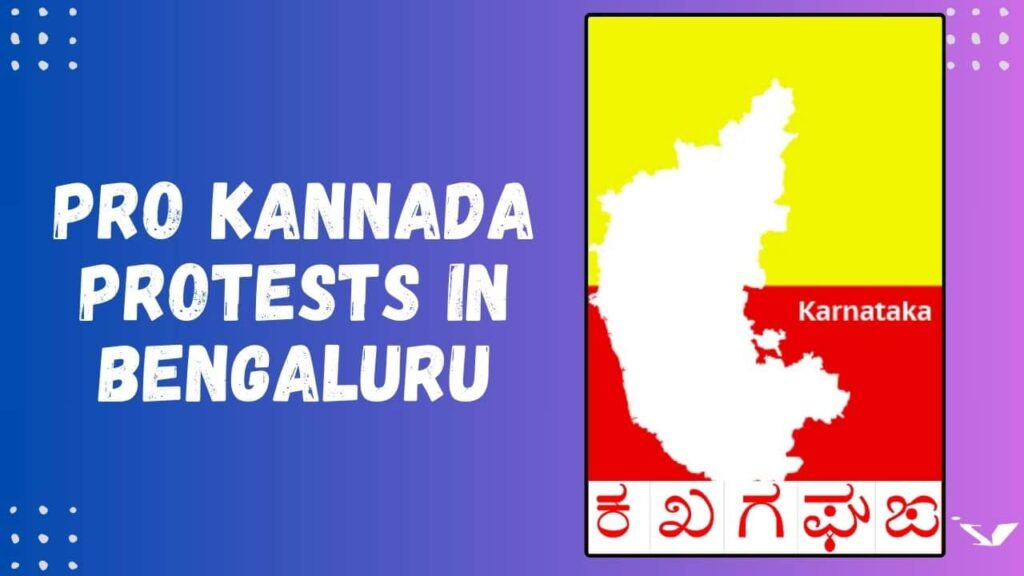Bengaluru’s Pro Kannada Protests: Revealing the Dilemma of Language
A Surprising Turn of Events

Bengaluru recently witnessed a surprising spectacle as a pro-Kannada group, rallying under the banner of “pro Kannada protests,” took to the streets, making headlines through acts of vandalism targeting hoardings and billboards. This article navigates through the chaos, unraveling the intricate layers surrounding the protests against the prevalent use of English in advertisements and signboards.
The Ripple Effect
The repercussions of this unexpected turn of events have extended beyond mere headlines, causing ripples of concern among investors and businessmen. Questions loom over the law and order situation and the potential business impact resulting from the targeted attacks on billboards and signs.
The March and the Mayhem
The Karnataka Rakshana Vedike (KRV) in Action
On December 27, a faction of the Karnataka Rakshana Vedike (KRV) orchestrated a march from the Sadahalli toll gate towards the city. Simultaneous protests erupted in various business hubs, leading to an unsettling atmosphere.
The Fallout – FIRs and Arrests
Bengaluru’s Commissioner of Police, B Dayananda, reported a flurry of activity, including the filing of 10 FIRs and the arrest of 53 individuals, including KRV president TA Narayana Gowda. The aftermath paints a picture of legal consequences and a city grappling with the aftermath of vehement demonstrations.
Unpacking the Pro kannada Protests Motivation

The “Deadline” Set by KRV
The KRV, in an assertive move, set a “deadline” for all Bengaluru establishments. This deadline revolves around a Bruhat Bengaluru Mahanagara Palike (BBMP) order, specifically addressing the use of Kannada in signs across the city.
The BBMP Circular and its Mandate
The BBMP recently issued a circular, adding weight to the KRV’s demands. It mandates all commercial establishments to prominently display signage in Kannada before February 28, 2024. The sprawling 1,400 km of arterial and sub-arterial roads in Bengaluru are now slated for zone-wise surveys, with notices to be served to non-compliant establishments.
A Familiar Echo: 2019 Revisited
This isn’t the first time such an order has been issued. In 2019, the civic body attempted to enforce similar regulations based on the Outdoor Signage and Public Messaging Bye-Laws of 2018. The Kannada Development Authority (KDA) directed the BBMP to cancel licenses of shops not adhering to the requirement of having 60 per cent of nameplates in Kannada. However, these directives faced challenges in effective implementation, leading to “pro Kannada protests” against the measures.
Tracing Roots to the Sarojini Mahishi Report
The roots of this linguistic mandate can be traced back to the government’s 1986 Sarojini Mahishi report. It advocated for Kannada to cover 60 per cent of nameplates, allowing the remaining 40 per cent to be in any other language. The report also emphasized prioritizing job opportunities for Kannadigas in Karnataka, a recommendation that, over the years, has seen limited implementation.
The Ongoing Pro kannada Protests: A Closer Look
The Lingering Impact
This article aims to shine a light on the ongoing protests and the government’s stance on this language-based issue in Bengaluru. It seeks to untangle the web of linguistic turmoil, shedding insight on the motivations driving the protests and the historical context that has shaped the current landscape.
Beyond the Headlines
Beyond the headlines, the Pro Kannada protests underscore a deeper issue of linguistic identity and cultural preservation. It prompts a closer examination of the delicate balance between promoting regional languages and accommodating the diverse linguistic fabric that characterizes Bengaluru.
Government Response: Navigating the Linguistic Storm
The Tightrope Walk
The government’s response to the protests is crucial in understanding the delicate dance between linguistic preservation, economic considerations, and the need for a harmonious coexistence of languages.
Striking a Balance
As the Pro Kannada protests unfold, questions arise about the government’s ability to navigate through the linguistic storm. Striking a balance between respecting cultural identities and fostering an environment conducive to business requires a nuanced approach.
Want to visit Bangalore? Check out: Top 15 Wonderful Tourist Places To Visit In Bangalore
Conclusion
Untangling the Linguistic Web
In conclusion, the Pro Kannada protests in Bengaluru against the use of English in advertisements and signboards reveal a complex tapestry of linguistic sentiments and cultural aspirations.
A Call for Dialogue
While the arrests and FIRs grab attention, there is a pressing need for open dialogue. Addressing the concerns of all stakeholders and finding common ground is essential to navigating the linguistic storm Bengaluru finds itself in.
FAQs
1. What triggered the recent protests in Bengaluru against the use of English in advertisements and signboards?
A: The protests were triggered by a pro-Kannada group, Karnataka Rakshana Vedike (KRV), in response to the prevalent use of English. They orchestrated acts of vandalism targeting hoardings and billboards.
2. What is the significance of the “deadline” set by the KRV for Bengaluru establishments?
A: The KRV set a “deadline” related to a Bruhat Bengaluru Mahanagara Palike (BBMP) order, requiring all commercial establishments to prominently display signage in Kannada before February 28, 2024.
3. How has the BBMP responded to the demands of the KRV?
A: The BBMP issued a circular mandating the use of Kannada in signs across the city, aligning with the KRV’s demands. Non-compliant establishments are slated for zone-wise surveys, with notices to be served.
4. What historical context can be traced in the government’s language-based mandates, as mentioned in the article?
A: The linguistic mandates find roots in the government’s 1986 Sarojini Mahishi report, advocating for Kannada to cover 60 per cent of nameplates, with the remaining 40 per cent in any other language.
5. How does the article suggest addressing the ongoing protests and finding common ground?
A: The article emphasizes the need for open dialogue, addressing the concerns of all stakeholders and finding a balance between linguistic preservation, cultural identity, and fostering a business-friendly environment.
Picture credits: https://www.pexels.com/ ; https://pixabay.com/
Like this post?
Give a glance to our other posts too : https://indyviews.in/blogsy/
